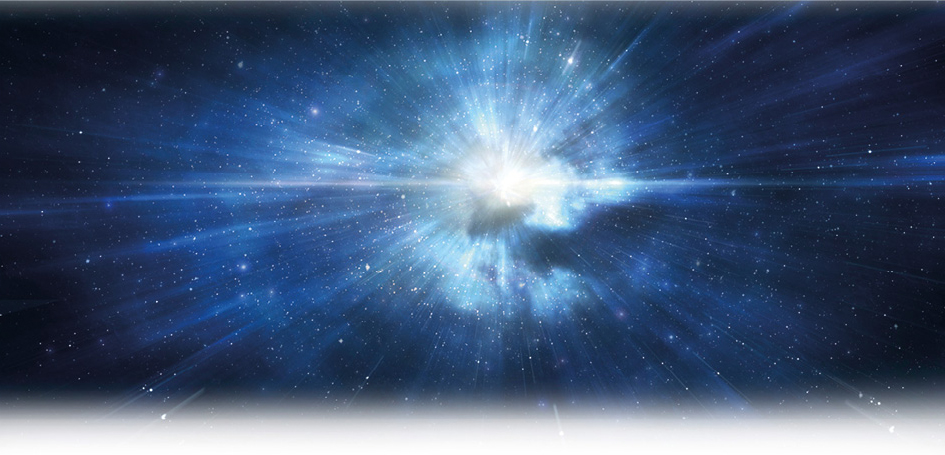

Scientific Evidence in Favor of God
The Biblical Account of Creation
Guitar in hand, broken voice torn with pain, and eyes flooded with sadness, Brazilian singer Leonardo moves the crowd with his ballads:
I don’t know where I am going,
I may never arrive at something,
My life follows the sun,
In the vast horizon,
I don’t even know who I am…
Many men and women on this planet ask themselves the same question: What am I doing here? Where do I come from? Where am I going? Is there life beyond this one? And before these existential questions, philosophers, writers, and thinkers try in vain to reply to the instinctive clamor of the human heart.
Libraries are crammed with books about the origin and meaning of life. Different hypotheses, various trends, abundant ideologies, multi-faceted opinions, some improbable, laughable, and ridiculous; others whimsical, creative, and sophisticated. But to date, none have been able to explain how such a complex, enormous, and wonderful universe like ours emerged. It is suggested, speculated, and argued about; yet no one can prove anything.
Aristotle, was one of the first to mention the theory of spontaneous generation, supported during the middle of the fourth century B.C., that some life forms such as worms and tadpoles were formed in the mud when heated by the sun, and that flies were produced from the decomposed flesh of animal carrion.1 Aristotle’s convictions stood for centuries until, during the middle seventeenth century, Italian biologist Francesco Redi, demonstrated that the larvae of flies were formed in flesh only if living flies had previously laid their eggs there. Therefore, no life form could originate from inanimate matter.2
In the same era English physiologist William Harvey, while studying the reproduction and development of deer, discovered that the life of every animal begins in a fertilized egg.3 A century later, Italian priest Lazarro Spallanzani wrote about the importance of spermatozoa in the reproductive process of mammals.4

Despite these discoveries, the theory of spontaneous generation continued to receive support for a long time, at least in the case of tiny animals such as microorganisms. In 1861, thanks to Louis Pasteur and his experiments related to bacteria, this theory became completely obsolete.5
THE PROLONGED SEARCH FOR AN EVOLUTIONARY MECHANISM
CLASSIFICATION AND PERIOD |
PRINCIPLE EXPONENTS |
CHARACTERISTICS |
Lamarckism |
Lamarck |
Use causes the development of new characteristics that are passed on in the form of inheritance. |
Darwinism |
Darwin, Wallace |
Minor changes, under the control of natural selection, lead to survival of the fittest. Heredity is imparted through gemmules. |
Mutations |
Morgan, de Vries |
Emphasis on major mutational changes. Natural selection is not as important. |
Modern Synthesis |
Chetverikov, Dobzhansky, Fisher, Haldane, Huxley, Mayr, Simpson, Wright |
Unified approach. Changes in populations are important. Minor mutations under the control of natural selection. Relationship with traditional classification. |
Divergence |
Eldredge, Gould, Grassé, Henning, Kauffman, Kimura, Lewontin, Patterson, Platnick |
Multiplicity of contradictory ideas. Dissatisfied with modern synthesis. Emphasis on cladistics. Search of a cause for complexity. |
Excerpt from: Ariel A. Roth, Science Discovers God, Hagerstown: Review & Herald, 2008, p. 161.

Another theory related to the origin of life is panspermia, which suggests that life originated on another planet, and bacteria from it dispersed life throughout the universe, also arriving on earth. This idea had its origin in some of the considerations by Greek philosopher Anaxagoras, but it was Swiss chemist Svante August Arrhenius, who in 1908 used the word “panspermia” to explain the beginning of life in outer space.6 The unanswered question by panspermia is “How did life emerge on that other planet?”
A third theory in relation to the origin of life is called naturalism. According to this supposition, life began sometime between 4.4 and 2.7 million years after pre-existing matter.7 Naturally, the unsettling question for supporters of this theory is: Where did that pre-existing matter come from? Some of these supporters, such as historian and philosopher of bioscience Harmke Kamminga, ask: “Of what, exactly, are we trying to explain the origin?”8 Or, as posited by pioneer and theorist of evolutionary chemistry, Alexander Oparin, the issue as to the nature of life and the issue of its origin have become inextricable. In other words, what came first: the egg or the chicken? Naturalists agree on only one thing: It is necessary to prepare an agenda to see what you want to discover.9
Naturalists believe that the diversity of life forms on earth emerged as a result of transformations and changes rising out of a common ancestry. To describe such changes, the word “evolution” was applied for the first time in the eighteenth century by Swedish biologist Charles Bonnet.10 Nonetheless, the concept that life on earth would have evolved from a common ancestor had already been formulated by various Greek philosophers, and the hypothesis that species would continually transform was postulated by a significant number of scientists from the eighteenth and nineteenth centuries.

Charles Darwin, the most famous of naturalists, cited these Greek philosophers in the first chapter of his book On the Origin of Species. However, it was Darwin himself in 1859 who synthesized a coherent body of observations that consolidated the concept of evolution into one so-called scientific theory.11
SCIENTIFIC EVIDENCE IN FAVOR OF GOD
CATEGORY |
DESCRIPTION |
| 1. MATTER |
|
| 2. FORCES |
|
| 3. LIFE |
|
| 4. ORGANISMS |
|
| 5. TIME |
|
| 6. FOSSILS |
|
| 7. MIND |
|
Retrieved from: Ariel A. Roth, Science Discovers God, Hagerstown: Review & Herald, 2008, p. 294.

The Darwinian assertion that complex creatures would have naturally evolved from unsophisticated creatures is merely one more hypothesis. It is not a fact; it has not been scientifically proven and cannot be proven in a laboratory. A scientific theory is a statement derived from actual evidence in the natural world. The key to good scientific reasoning begins with the collection of such evidence. Thereafter, alternative hypotheses are developed and compared in light of evidence found.
From this point of view, Darwin’s theory, as many others, has not been able to be proven. For that reason, it has undergone many changes over the years to accommodate available evidence. In reality, what is known as “the theory of evolution” is, paradoxically, a theory in evolution.
What does the Bible say about the origin of life and the planet? The Bible begins with an assertive declaration: “In the beginning God created the heavens and the earth” (Gen. 1:1). The biblical author is not concerned with proving that Creation is real. He does not debate or argue. He simply presents the creative God and accurately describes His creative work. God is God.
According to this account, in the beginning there was nothing, only God existed. This declaration contradicts what many affirm by stating that matter was also eternal, that something always existed, from which the process of evolution arose.
The Bible is categorical in asserting that in the beginning only God existed. This is stated not only in the book of Genesis, but also by the author of the letter to the Hebrews: “By faith we understand that the universe was formed at God’s command, so that what is seen was not made out of what was visible” (Heb. 11:3). The biblical declaration does not require much explanation: what is seen was made out of what was not seen. There was nothing before God created the universe; He is the beginning of everything. Before God nothing existed; He created everything from nothing.

In Hebrew, the verb bara means “to create from nothing.” Four verbs in the Hebrew Bible can be translated “to create”: bara, asah, qanah, and yatsah (“to be created”). In three of these verbs, the subject that creates can be God or a human being who creates from something. However, in the verb bara, only God can be the Creator, never a human,12 because a human being can only create something from existing matter. Only God creates from nothing.
The wonderful aspect of the biblical account is that God did not create the world and abandon it to its own process of natural development; rather, He has interest in its care. That protective behavior is observed from the beginning, when the Spirit of God moved upon the face of the waters.
The verb “to move” is used only twice in the Bible, in the account of the Creation and in the book of Deuteronomy: “Like an eagle that stirs up its nest and hovers over its young, that spreads its wings to catch them and carries them aloft” (Deut. 32:11). Moses, the author of this book of the Bible, compares God to a mother eagle that looks after her fledglings lovingly, hovering or moving above them. That is exactly what the Spirit did in the beginning: He moved upon the waters with the desire to put everything in order. Isn’t this interesting? At times, beaten down by life, we may think God is absent. But that is not so. He is near, like an eagle looking after her young.
At this stage you may ask, where is the evidence of those assertions? Can what the Bible says be proven in a laboratory? No, because the Bible is not a book about science, it does not make such claim. The Bible is a book of faith with instructional language. Its objective is to show spiritual principles that link human beings to their Creator. It is a matter to be decided, trusted, or doubted, to believe or disbelieve.
Does it seem difficult to believe in something without analyzing it in a laboratory? We believe many things without bothering to analyze them.
For example, when you feel a headache you head to the pharmacy, purchase medicine, and take it feeling confident that it will be good for you. You do not know the pharmacist in charge of the pharmacy, or the owner of the establishment, or the person who sold you the product. But you trust them; you exercise faith without even knowing who they are.
When traveling, you make your way to the airport, enter the plane without knowing the identity of the pilot or the flight crew members. You sit in comfortably and sleep, trusting that upon waking up you will have reached your destination. But what if the pilots took you to the Bermuda Triangle and abandoned you there? Despite the lack of awareness and doubt, do you trust them?
We practice faith in many of life’s circumstances. It is unnecessary to take love to a laboratory to believe that love exists, nor is it necessary to feel pain to know that pain is real. We believe many things without finding it necessary to test them. Something similar occurs with God: the manifestations of His existence and His creative power are everywhere.
David, the author of the Psalms, stated: “The heavens declare the glory of God; the skies proclaim the work of his hands. Day after day they pour forth speech; night after night they reveal knowledge. They have no speech, they use no words; no sound is heard from them” (Ps. 19:1-3).
The psalmist mentions the heavens as silent witnesses to the power of God. No words, arguments, or philosophies are necessary. We have only to look skyward and be honest with reason itself. There must be a Creator behind something so grand, beautiful, and designed with such perfection. The heavens and the earth give testimony day after day and night after night that God created all things. “They have no speech, they use no words; no sound is heard from them.”
People may not believe, but the evidence is irrefutable. How is it possible to explain the fact that the earth is located at an exact distance from the sun to make life possible on this planet? How did the moon end up situated at the precise location to help control the movement of the tides? Why do the sun, moon, earth, and stars travel established routes? If they were to change routes, a universal cataclysm would occur.
Most scientists, even those who do not believe in God, agree that the observation of the universe leads them to conclude that everything appeared with a purpose. That is true: God created the world with a purpose. Our lives have purpose. Nothing exists by chance, least of all us. The fact that at this moment things are not all well in our lives does not mean that we were born by accident, or that our fate is to suffer. God has a glorious plan for us, and if we believe and wait we will see such plans come true.

How did God make the universe? The prophet Jeremiah wrote: “It is he who made the earth by his power, who established the world by his wisdom, and by his understanding stretched out the heavens. When he utters his voice there is a tumult of waters in the heavens, and he makes the mist rise from the ends of the earth. He makes lightning for the rain, and he brings forth the wind from his storehouses” (Jer. 51:15,16, ESV). The prophet mentions divine wisdom and intelligence as part of His creative power.
Likewise, the Scriptures mention the power of His Word and assure the following: “By the word of the Lord the heavens were made, their starry host by the breath of his mouth. He gathers the waters of the sea into jars; he puts the deep into storehouses” (Ps. 33:6,7). Here the question arises: If, when nothing existed, everything came into existence by the power of the word of God, how could He not restore the life of those who think there is no remedy for their situation?
Many times I have come across individuals devastated by life or by their own mistakes. They are human beings who have lost the will to fight, people who think they have hit rock bottom. However, I could present hundreds, if not thousands of arguments, about the restorative power of God. Therefore, when we feel that everything is lost, when we believe there is no way out, when from a human point of view we have destroyed it all, we can look to the heavens and ask: Who created all those celestial wonders? God. How did He accomplish it? With the power of His word. Does He not have the power to transform our lives as well?
The power of God is not grasped by human understanding. The apostle John says: “In the beginning was the Word, and the Word was with God, and the Word was God. He was with God in the beginning. Through him all things were made; without him nothing was made that has been made.… The Word became flesh and made his dwelling among us. We have seen his glory, the glory of the one and only Son, who came from the Father, full of grace and truth” (John 1:1-3,14). John affirms that Jesus is the Word of God, and that He was with the Father at the beginning of Creation. Meanwhile, the apostle Paul teaches: “For him all things were created: things in heaven and on earth, visible and invisible, whether thrones or powers or rulers or authorities; all things have been created through him and for him” (Col. 1:16). Both John and Paul assert that God created all things.
The expression “everything” is interesting. What is “everything”? Let’s discuss, for example, the volume of the planets. One thousand planets the size of earth fit within Jupiter, and 1.2 million planets like Jupiter fit within the sun, with additional space for more than 4 million moons. Can we fathom the vastness of the universe?
Alpha Centauri, the stellar system closest to the sun, is five times the size of our solar system. A ray of light travels at a speed of 300,000 kilometers per second. At such speed, we would arrive at the moon in one and a half seconds; at mercury, four and a half minutes; and at Jupiter, in 35 minutes. And we are just talking about one insignificant galaxy in a formidable universe!
Consequently, it is somewhat naive to attempt to explain the origin of life and the universe through human speculation. What we can or cannot see must have been designed by a mind greatly superior to that of any human being.
The Bible not only declares that Jesus Christ made all things, but also that He keeps them in place: from atoms to cells, to planets and galaxies. No planet or star remains in its orbit on its own; no atomic components such as protons, neutrons, and electrons continue to rotate in perfect balance on their own. Jesus maintains them in mathematical equilibrium! Scientists cannot explain how atomic particles exist without suffering a collision. It is a mystery known as “nuclear glue.”13 But the Bible says that Jesus Christ is that nuclear glue, the One who holds all things together; the One who controls Creation! If the nuclear glue disappeared, everything would be highly explosive; and that has been proven in the use of nuclear weapons.
The apostle Peter says that will happen in the future. Then Jesus Christ, with all certainty, will remove the “nuclear glue”—His own power—and everything will be dissolved. Notice how Peter describes it: But the day of the Lord will come like a thief. The heavens will disappear with a roar; the elements will be destroyed by fire, and the earth and everything done in it will be laid bare. Since everything will be destroyed in this way, what kind of people ought you to be? You ought to live holy and godly lives as you look to the day of God and speed its coming. That day will bring about the destruction of the heavens by fire, and the elements will melt in the heat” (2 Pet. 3:10-12).
The problem is that sometimes Christians themselves are unable to believe in the power of God. That is the case of theistic evolutionists. Theistic evolution, or evolutionary creationism as it is also known, acknowledges that living beings have come to be through a process of natural evolution “without direct intervention from God.” It attributes to God the origin of the laws of nature, but “without believing that God acts directly” in the development of natural processes. Theistic evolutionism is neither creation nor evolution. More precisely it is a betrayal to both. It is a desperate effort to harmonize both positions without offending anyone.
Furthermore, the Bible declares: “How many are your works, Lord! In wisdom you made them all; the earth is full of your creatures” (Ps. 104:24). To what works is the psalmist referring? This psalm is a splendid poetic piece about Creation. Everything was created by the power of the Word of God, including basic matter. Thus David adds: “He set the earth on its foundations; it can never be moved” (Ps. 104:5). Theistic evolutionists believe the earth was created and abandoned for millions of years. Why? Because they believe there is insufficient “proof” to reconcile the biblical account of Creation with that of science. They are afraid to accept things as they are stated in the Bible.
The same occurs with the story of Creation. Attempting to bridge Creation with what is expressed through geology or science to provide a scientific basis can be a good intention; however, it is unnecessary. The essential thing is to believe in the power of God. The Bible says the heavens and the earth were created by the power of His Word. There is no way to scientifically prove that the Word has such power. One must accept it through faith.
There are moments in life when human beings have to remove themselves from the pedestal of their rationale and enter the unknown dimension of faith. In such circumstances reason is useless. What do you do when your home falls apart, or your son is consumed by the use of drugs, and reason is unable to change the state of things? Where do you go?
Go to Jesus and allow Him to heal your wounds!

1. D. M. Balme, “Development of Biology in Aristotle and Theophrastus: Theory of Spontaneous Generation,” Phronesis, 7: 91–104, (1962).
2. F. Redi, Expériences sur la génération des insectes et autres écrits de science et de littérature. Traduction, introduction et notes d’André Sempoux, Presses universitaires de Louvain, Travaux de la Faculté de philosophie, arts et lettres de l’UCL, V, section Philosophie et lettres II, 1970, pp. 1-96.
3. National Anti-Vivisection Society, The animal’s defender and zoophilist, vol. 13, London: The Victoria Street Society for the protection of animals from Vivisection, 1894, p. 297.
4. L. Spallanzani, Expériences pour servir à l’histoire de la génération des animaux et des plantes, Genève, 1786, pp. 10-15 and 20-23 for the examples about the frogs, gallica.bnf.fr. Accessed August 17, 2015.
5. L. Pasteur, “Sur les relations qui peuvent exister entre la forme cristalline, la composition chimique et le sens de la polarisation rotatoire,” Annales de Chimie et de Physique, 24: 442-459, (1848).
6. S. Arrhenius, “On the influence of Carbonic Acid in the Air upon the Temperature of the Ground,” Philosophical Magazine and Journal of Science, Series 5, 41: 237-276, (1896).
7. S. A. Wilde, J. W. Valley, W. H. Peck, C. M. Gram, “Evidence from detrital zircons for the existence of continental crust and oceans on the Earth 4.4 Gyr ago,” Nature, 409:175-178, (2001).
8. H. Kamminga, “Protoplasm and the Gene,” Clay Minerals and the Origin of Life, Cambridge: ed. A. G. Cairns-Smith & H. Hartman, 1986, pp. 1-10.
9. F. Crack, J. Watson, “A Structure for Deoxyribose Nucleic Acid,” Nature, 171:737, (1953); F. Crack, J. Watson, “Genetical Implications of the Structure of Deoxyribose Nucleic Acid,” Nature, 171:964-967, (1953); T. D. Schneider, “Information Content of Individual Genetic Sequences,” Journal of Theoretical Biology, 189: 427-441, (1997).
10. R. Richards, The Meaning of Evolution: the Morphological Construction and Ideological Reconstruction of Darwin’s Theory, Chicago: The University of Chicago Press, 1993, p. 10.
11. C. Darwin, A. Wallace, “On the tendency of species to form varieties: and on the perpetuation of varieties and species, by natural means of selection,” Journal of the Proceedings of the Linnean Society of London. Zoology, 3: 45-62, (1858).
12. G. J. Wenham, Word Biblical Commentary, Genesis 1–15, Vol. 1, Dallas: Word, Incorporated, 1998, p. 14.
13. R. Brandelik, “Evidence for Planar Events in Annihilation at High Energies,” Physics Letters B, 1979, pp. 243–249.